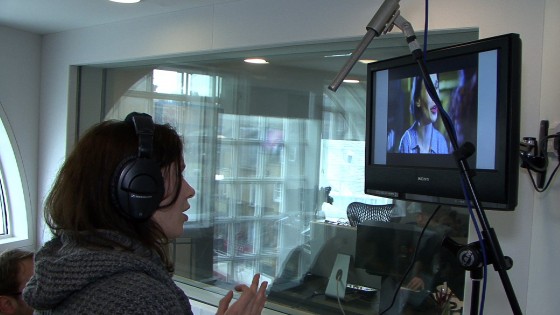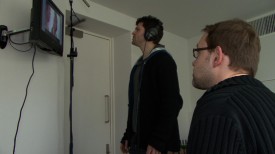Here’s a quick demonstration of the huge difference that sound design can make. This video contains a scene from the final cut of Soul Searcher, but still with the original production sound, followed by the same scene after the processes of sound editing, design and mixing were completed.
The music makes a big difference, of course, but putting that to one side, the sound effects have really brought the scene to life. And bear in mind that I did the sound design on this film. If a proper, experienced sound designer had done it, I’m sure it would be a hundred times better still.
First of all, the location, the villain’s lair, has been given a character through atmos tracks. The fluorescent hum is actually a combination of an electricity substation, recorded outside a local shopping centre here in Hereford late one night, and my own voice humming, layered up several times. The human element adds some randomness and makes the sound more alive.
There’s also an airy sound which is my mum’s gas oven, representing a Bunsen Burner that’s established in the room earlier in the film. This high frequency sound lightens everything up and gives it a sense of space.
The thick chains which Danté is carrying were ingeniously made by production designer Ian Tomlinson out of rolled-up newspaper. Clearly it was necessary to replace the light, crinkly noises this made on set with the heavy clanks of genuine metal chain. These were sourced from an online library called Sounddogs.
The smaller chain was real metal, but you’ll notice in the production audio that what little sound it makes is weak and off-mike. This is absolutely normal; your sound recordist’s job is to get the dialogue as clearly as possible; everything else can be re-recorded in post and therefore each element can be miked closely for the best possible sound. Using a length of the chain which I had kept from production, I recorded the sounds of it being handled and dragged over the lip of the chest using a coffee table in my living room.
The chains are the MacGuffin of the story, so giving them thick, clean, satisfying sounds is vital to cement them as key elements in the audience’s mind.
Ideally the chest used as a prop would have been more ancient-looking, but that was the best one we were able to get on our budget. However, adding the sound of a friend’s squeaky bathroom doorknob as Danté opens the lid helped to age prop the little.
Finally, once all these lovely clean sound effects were track-laid, they were all treated with reverb by mixer Neil Douek, to help them feel real, to tie them all together, and to convey the scale of Danté’s lair.
How have you used sound design in your own films to help tell the story?


